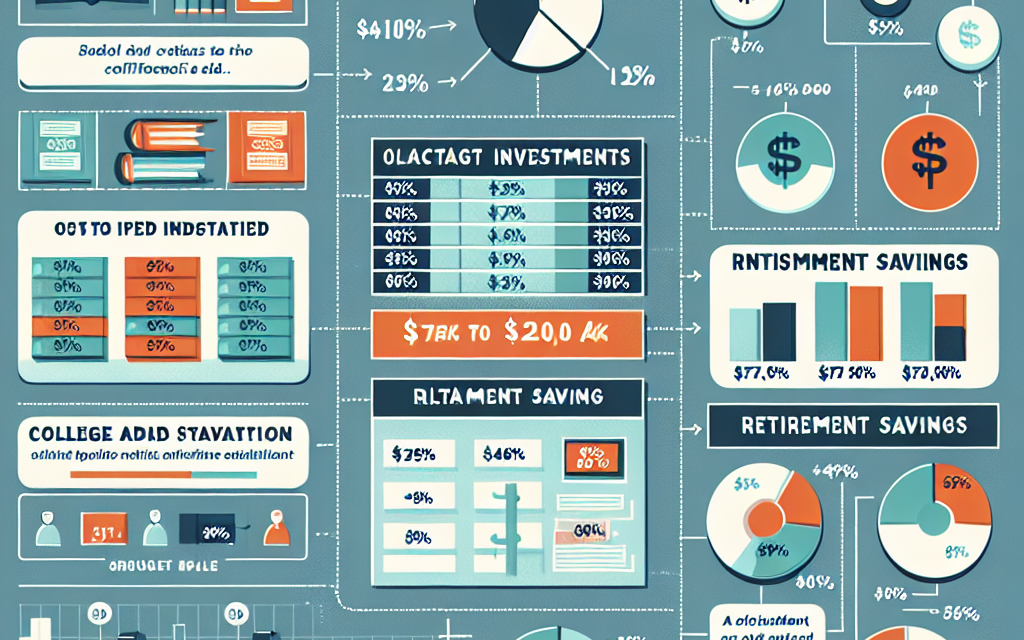“Maximize Your College Financial Aid: Smart Strategies for $750K in Investments and Retirement Savings.”
Introduction
Optimizing college financial aid is crucial for families with significant investments and retirement savings, such as $750,000, as these assets can impact eligibility for need-based aid. Understanding the nuances of financial aid formulas, including the Expected Family Contribution (EFC), is essential. Strategies may include restructuring assets, maximizing tax-advantaged accounts, and timing income recognition to minimize the impact on financial aid assessments. Additionally, exploring scholarships, grants, and alternative funding sources can further enhance financial support for college expenses. By strategically managing investments and savings, families can effectively navigate the financial aid landscape and secure the necessary resources for higher education.
Maximizing Financial Aid Eligibility
Maximizing financial aid eligibility is a crucial step for families looking to navigate the complexities of college funding, especially when significant investments and retirement savings are involved. Understanding how these financial assets impact aid calculations can empower families to make informed decisions that enhance their eligibility for assistance. The Free Application for Federal Student Aid (FAFSA) and the CSS Profile are the primary tools used to assess a student’s financial need, and both have specific guidelines regarding asset reporting.
To begin with, it is essential to recognize that not all assets are treated equally in the financial aid process. For instance, while cash, savings accounts, and investments are considered available resources, certain retirement accounts, such as 401(k)s and IRAs, are generally excluded from the calculation of available assets. This distinction is vital because it allows families to prioritize retirement savings without jeopardizing their financial aid eligibility. Therefore, families with $750,000 in investments and retirement savings should consider strategies that protect their retirement assets while optimizing their financial aid prospects.
One effective strategy is to minimize the amount of reportable assets on the FAFSA. Families can achieve this by strategically using their liquid assets to pay down debt or cover necessary expenses before filing the FAFSA. For example, paying off high-interest loans or making significant purchases can reduce the amount of cash and savings reported, thereby potentially increasing financial aid eligibility. Additionally, families may consider transferring assets into non-reportable accounts, such as certain types of retirement accounts, which can further shield these funds from financial aid calculations.
Moreover, timing can play a critical role in maximizing financial aid eligibility. Families should be mindful of when they file the FAFSA, as the financial information reported is based on the prior-prior year’s income. Therefore, if a family anticipates a significant drop in income or an increase in expenses, it may be advantageous to delay filing until the financial situation reflects these changes. This approach can lead to a more favorable assessment of financial need, ultimately resulting in increased aid.
In addition to managing assets, families should also explore various financial aid opportunities available to them. Scholarships, grants, and work-study programs can significantly supplement financial aid packages. By actively seeking out and applying for scholarships, families can reduce the overall cost of college, which may allow them to allocate more of their resources toward investments and savings without negatively impacting their financial aid eligibility. Furthermore, some colleges offer institutional aid that takes into account a family’s unique financial situation, so it is beneficial to communicate openly with financial aid offices about any special circumstances.
Lastly, it is important for families to stay informed about changes in financial aid policies and regulations. The landscape of college funding is continually evolving, and being proactive in understanding these changes can provide families with additional strategies to optimize their financial aid eligibility. Engaging with financial advisors or college financial aid consultants can also offer personalized insights tailored to a family’s specific financial situation.
In conclusion, maximizing financial aid eligibility requires a multifaceted approach that considers asset management, timing, and proactive engagement with available resources. By implementing these strategies, families with substantial investments and retirement savings can enhance their financial aid prospects, ultimately making higher education more accessible and affordable.
Strategic Asset Allocation for Aid Optimization
When it comes to optimizing college financial aid, strategic asset allocation plays a crucial role, particularly for families with significant investments and retirement savings. Understanding how different assets are treated in the financial aid process can help families make informed decisions that maximize their eligibility for aid. The Free Application for Federal Student Aid (FAFSA) and the CSS Profile are the primary tools used to assess a family’s financial situation, and they consider various assets differently. Therefore, a well-thought-out approach to asset allocation can significantly impact the amount of aid a student may receive.
To begin with, it is essential to recognize that the FAFSA primarily assesses parental assets, which are weighted more heavily than student assets. For instance, while only 20% of a student’s assets are considered available for college expenses, up to 5.64% of parental assets are factored into the Expected Family Contribution (EFC). This disparity highlights the importance of strategically positioning assets in a way that minimizes their impact on financial aid calculations. One effective strategy is to prioritize assets that are not counted in the FAFSA formula, such as retirement accounts. Funds held in 401(k)s, IRAs, and other retirement savings vehicles are generally excluded from the financial aid assessment, allowing families to preserve their savings for retirement while still qualifying for aid.
Moreover, families should consider the timing of asset liquidation. For example, if a family has significant liquid assets, such as cash or investments in taxable accounts, it may be beneficial to delay withdrawing these funds until after the FAFSA is submitted. This approach can help reduce the reported asset value during the financial aid assessment period, thereby potentially increasing eligibility for need-based aid. Additionally, families should be mindful of the impact of income on financial aid eligibility. Since the FAFSA looks at income from the prior tax year, families may want to consider strategies such as deferring income or maximizing deductions to lower their reported income, which can further enhance their financial aid prospects.
In addition to managing liquid assets, families should also evaluate their investment portfolios. Diversifying investments across various asset classes can help mitigate risk while optimizing returns. However, it is crucial to consider how these investments are categorized. For instance, investments in real estate or business equity may be treated differently than stocks or bonds. Families should consult with financial advisors to ensure that their investment strategies align with their financial aid goals. Furthermore, it may be advantageous to explore options such as 529 college savings plans, which offer tax advantages and favorable treatment in financial aid calculations. Contributions to these plans are considered parental assets, but they are assessed at a lower rate than other investments, making them an attractive option for families looking to save for college.
Ultimately, the key to optimizing college financial aid lies in a comprehensive understanding of how different assets are treated in the financial aid process. By strategically allocating assets, families can minimize their EFC and maximize their eligibility for financial aid. This approach requires careful planning and consideration of both current financial circumstances and future educational expenses. As families navigate the complexities of college financing, a proactive and informed strategy can make a significant difference in the affordability of higher education. By leveraging the nuances of asset allocation, families can position themselves to secure the financial support necessary for their students to succeed in college.
Utilizing 529 Plans Effectively
When it comes to optimizing college financial aid, one of the most effective strategies involves the judicious use of 529 plans. These tax-advantaged savings accounts are specifically designed to encourage saving for future education costs, making them a valuable tool for families with substantial investments and retirement savings. By understanding the nuances of 529 plans, families can maximize their financial aid eligibility while simultaneously growing their education savings.
To begin with, it is essential to recognize that 529 plans offer significant tax benefits. Contributions to these plans grow tax-free, and withdrawals for qualified education expenses are also tax-free. This feature not only enhances the overall growth of the investment but also allows families to allocate more funds toward college expenses without the burden of taxation. Therefore, families with $750,000 in investments and retirement savings should consider directing a portion of their assets into a 529 plan to take advantage of these benefits.
Moreover, the impact of 529 plans on financial aid calculations is relatively favorable compared to other assets. When determining a family’s expected family contribution (EFC), colleges typically assess the value of assets held in a 529 plan differently than they would assess other investments. For instance, while a portion of assets in a 529 plan may be counted in the financial aid formula, the impact is often less significant than that of assets held in the parents’ names or other investment accounts. This distinction allows families to preserve more of their financial aid eligibility while still saving for education.
In addition to understanding the tax implications and financial aid calculations, families should also consider the timing of their contributions to a 529 plan. Contributions made early in a child’s life can benefit from compounding growth over time, potentially resulting in a more substantial nest egg by the time college arrives. Conversely, waiting until closer to college enrollment may limit the growth potential of the investment. Therefore, families should develop a long-term savings strategy that incorporates regular contributions to the 529 plan, ensuring that they maximize the benefits of compounding interest.
Furthermore, it is crucial to select the right 529 plan that aligns with the family’s financial goals and investment preferences. Each state offers its own 529 plan, and while some may provide tax deductions for contributions, others may have lower fees or better investment options. Families should conduct thorough research to identify a plan that not only meets their immediate needs but also offers flexibility for future adjustments as their financial situation evolves.
As families navigate the complexities of college financial aid, they should also remain aware of the potential for changing regulations and policies surrounding 529 plans. Staying informed about any updates or modifications can help families make timely adjustments to their savings strategies, ensuring they continue to optimize their financial aid eligibility.
In conclusion, utilizing 529 plans effectively is a critical component of a comprehensive strategy to optimize college financial aid. By taking advantage of the tax benefits, understanding the impact on financial aid calculations, contributing early, selecting the right plan, and staying informed about regulatory changes, families can significantly enhance their ability to fund higher education. With careful planning and strategic use of 529 plans, families can navigate the financial landscape of college education with greater confidence and success.
Timing Withdrawals from Retirement Accounts
When considering strategies to optimize college financial aid, one crucial aspect involves the timing of withdrawals from retirement accounts. This decision can significantly impact both the financial aid eligibility of a student and the long-term financial health of the family. Understanding how different types of retirement accounts are treated in the financial aid process is essential for making informed choices.
To begin with, it is important to recognize that the Free Application for Federal Student Aid (FAFSA) assesses a family’s financial situation based on various assets, including those held in retirement accounts. However, the treatment of these accounts can vary. For instance, funds in traditional IRAs and 401(k)s are generally not counted as assets on the FAFSA, which means that they do not directly affect the Expected Family Contribution (EFC). This can be advantageous for families with significant retirement savings, as it allows them to preserve these funds while still qualifying for financial aid.
Nevertheless, the timing of withdrawals from these accounts can have implications for financial aid eligibility. When families withdraw funds from retirement accounts, those distributions are often considered income in the year they are taken. This increase in reported income can lead to a higher EFC, thereby reducing the amount of financial aid a student may receive. Therefore, families should carefully consider the timing of any withdrawals, particularly in the years leading up to a student’s college enrollment.
One effective strategy is to delay withdrawals from retirement accounts until after the FAFSA has been submitted. By doing so, families can avoid inflating their income for the year in which they are applying for financial aid. This approach allows families to maintain their financial aid eligibility while still having access to necessary funds for educational expenses. Additionally, families should be mindful of the timing of their withdrawals in relation to the academic calendar. For instance, if a student is expected to enroll in college in the fall, it may be prudent to wait until after the FAFSA submission deadline to take any distributions.
Moreover, families should also consider the potential tax implications of withdrawing funds from retirement accounts. Distributions from traditional IRAs and 401(k)s are typically subject to income tax, which can further complicate financial planning. By strategically timing withdrawals, families can minimize their tax burden while maximizing their financial aid eligibility. For example, if a family anticipates a lower income year, it may be beneficial to withdraw funds during that period to take advantage of a lower tax bracket.
In addition to timing, families should explore alternative funding sources that do not impact financial aid calculations. For instance, utilizing 529 college savings plans can be a more favorable option, as these accounts are treated differently in the financial aid process. Contributions to a 529 plan are considered parental assets, which have a lower impact on financial aid compared to student assets. By prioritizing withdrawals from these accounts over retirement funds, families can optimize their financial aid package while preserving their retirement savings.
In conclusion, the timing of withdrawals from retirement accounts is a critical factor in optimizing college financial aid. By understanding how these withdrawals affect both financial aid eligibility and tax implications, families can make informed decisions that balance immediate educational expenses with long-term financial security. Through careful planning and strategic timing, families can navigate the complexities of financial aid and ensure that they are making the most of their resources as they support their students’ educational journeys.
Understanding the FAFSA and CSS Profile
Understanding the FAFSA and CSS Profile is crucial for families aiming to optimize college financial aid, especially when significant investments and retirement savings are involved. The Free Application for Federal Student Aid (FAFSA) is a standardized form that students must complete to determine their eligibility for federal financial aid, including grants, work-study, and loans. On the other hand, the College Scholarship Service (CSS) Profile, administered by the College Board, is used by many private colleges and universities to assess a family’s financial situation more comprehensively. Both forms play a pivotal role in the financial aid process, and understanding their nuances can significantly impact the aid a student receives.
To begin with, it is essential to recognize that the FAFSA primarily focuses on a family’s income and assets as of the date of application. This means that families with substantial investments or retirement savings must be strategic in how they report these assets. For instance, while the FAFSA does require families to disclose certain assets, it does not consider the value of retirement accounts, such as 401(k)s or IRAs, when calculating the Expected Family Contribution (EFC). This exclusion can be advantageous for families with significant retirement savings, as it allows them to present a lower EFC, thereby increasing their eligibility for need-based aid.
In contrast, the CSS Profile takes a more detailed approach by examining a broader range of financial factors. This includes not only income and liquid assets but also the value of investments, real estate, and even certain types of savings accounts. Consequently, families with $750,000 in investments must be particularly careful in how they report these assets on the CSS Profile. It is advisable to consult with a financial aid advisor or a tax professional to ensure that all information is accurately represented and that any potential exemptions or allowances are utilized effectively.
Moreover, understanding the timing of these applications is vital. The FAFSA opens on October 1 each year, and many colleges have their own deadlines for submission. Families should prioritize completing the FAFSA as early as possible to maximize their chances of receiving aid. Similarly, the CSS Profile has its own deadlines, which can vary by institution. By staying organized and adhering to these timelines, families can ensure that they are considered for the maximum amount of financial aid available.
Additionally, it is important to consider the impact of financial aid on overall college costs. While federal aid is often the first source of funding, many colleges also offer their own institutional aid, which can be influenced by the information provided in the CSS Profile. Therefore, families should not only focus on federal aid but also explore scholarship opportunities and institutional grants that may be available based on the information submitted in both the FAFSA and CSS Profile.
In conclusion, understanding the intricacies of the FAFSA and CSS Profile is essential for families with significant investments and retirement savings. By strategically reporting assets, adhering to deadlines, and exploring all available financial aid options, families can optimize their financial aid packages. This proactive approach not only alleviates the financial burden of college expenses but also ensures that students can focus on their education without the overwhelming stress of financial uncertainty. Ultimately, a well-informed strategy can make a substantial difference in the affordability of higher education.
Income Management Strategies for Aid
Navigating the complexities of college financial aid can be a daunting task, particularly for families with substantial investments and retirement savings. However, with strategic income management, it is possible to optimize financial aid opportunities while maintaining a healthy financial portfolio. One of the first steps in this process is to understand how income is assessed in the financial aid formula. The Free Application for Federal Student Aid (FAFSA) primarily considers the income of the student and their parents, which can significantly impact the expected family contribution (EFC). Therefore, families should evaluate their income levels and consider strategies to manage them effectively.
One effective approach is to minimize reported income in the year prior to applying for financial aid. This can be achieved through various means, such as deferring bonuses or delaying the sale of investments that may generate capital gains. By strategically timing income recognition, families can lower their reported income, which may lead to a more favorable EFC. Additionally, it is essential to consider the impact of tax strategies on income management. Utilizing tax-deferred accounts, such as IRAs or 401(k)s, can help families reduce their taxable income, thereby potentially increasing their eligibility for need-based aid.
Moreover, families should also explore the implications of asset management on financial aid. While the FAFSA assesses both income and assets, it is crucial to understand that not all assets are treated equally. For instance, retirement accounts are generally excluded from the financial aid calculation, which means that families can prioritize saving for retirement without negatively impacting their financial aid eligibility. Consequently, families with $750,000 in investments and retirement savings should consider reallocating some of their assets into retirement accounts to shield them from financial aid assessments.
In addition to managing income and assets, families should also be aware of the importance of educational savings accounts, such as 529 plans. Contributions to these plans are considered parental assets, which are assessed at a lower rate than student assets. Therefore, families can benefit from maximizing contributions to 529 plans, as this can help reduce the overall EFC while simultaneously providing a tax-advantaged way to save for college expenses. Furthermore, it is advisable to review the investment options within these plans to ensure they align with the family’s financial goals and risk tolerance.
Another critical aspect of income management is understanding the timing of financial aid applications. Families should be proactive in gathering necessary documentation and submitting their FAFSA and other financial aid applications as early as possible. Early submission can sometimes lead to better aid packages, as some institutions allocate funds on a first-come, first-served basis. Additionally, families should remain vigilant about any changes in their financial situation, such as job loss or unexpected medical expenses, which may warrant a reevaluation of their financial aid package.
In conclusion, optimizing college financial aid with significant investments and retirement savings requires a multifaceted approach to income management. By strategically managing income, reallocating assets, maximizing contributions to educational savings accounts, and being proactive in the financial aid application process, families can enhance their financial aid eligibility. Ultimately, these strategies not only help in securing financial assistance for college but also ensure that families maintain a balanced approach to their overall financial health.
Leveraging Scholarships and Grants
When navigating the complex landscape of college financial aid, leveraging scholarships and grants emerges as a pivotal strategy, particularly for families with substantial investments and retirement savings. Scholarships and grants provide essential financial support that does not require repayment, making them invaluable resources for reducing the overall cost of higher education. To optimize the potential for receiving these forms of aid, it is crucial to understand the various types available and the strategies that can enhance eligibility.
First and foremost, it is important to recognize the distinction between scholarships and grants. Scholarships are typically awarded based on merit, which may include academic achievement, athletic ability, or artistic talent. In contrast, grants are often need-based, taking into account the financial circumstances of the student and their family. Given the family’s significant investment portfolio and retirement savings, it is essential to approach the financial aid process with a clear understanding of how these assets may impact eligibility for need-based aid.
One effective strategy is to conduct thorough research on available scholarships and grants. Numerous organizations, including private foundations, corporations, and educational institutions, offer scholarships tailored to specific demographics, fields of study, or personal circumstances. By identifying scholarships that align with the student’s profile, families can increase their chances of securing funding. Additionally, many colleges and universities provide their own scholarships, which may be awarded based on both merit and need. Therefore, it is advisable to explore the financial aid offerings of prospective institutions early in the application process.
Moreover, families should consider the timing of their financial aid applications. Many scholarships and grants have specific deadlines, and submitting applications early can enhance the likelihood of receiving funding. Additionally, families should be mindful of the Free Application for Federal Student Aid (FAFSA) and the CSS Profile, as these forms are critical for determining eligibility for federal and institutional aid. Completing these applications accurately and promptly can open doors to various financial aid opportunities.
In addition to traditional scholarships and grants, families should explore niche scholarships that may be less competitive but still provide significant funding. These can include scholarships for students pursuing specific majors, those with unique hobbies or interests, or even scholarships aimed at underrepresented groups. By casting a wide net and applying for a diverse array of scholarships, families can maximize their chances of receiving financial support.
Furthermore, it is essential to maintain open communication with the financial aid offices of prospective colleges. These offices can provide valuable insights into available scholarships and grants, as well as guidance on how to navigate the application process. Engaging with financial aid advisors can also help families understand how their investments and retirement savings may affect their overall financial aid package.
Lastly, families should remain vigilant about scholarship renewal requirements. Many scholarships are awarded for multiple years but require students to maintain a certain GPA or complete a specific number of credit hours. By staying informed about these requirements, families can ensure that they continue to receive funding throughout the student’s college career.
In conclusion, leveraging scholarships and grants is a critical strategy for optimizing college financial aid, especially for families with substantial investments and retirement savings. By conducting thorough research, applying early, exploring niche opportunities, and maintaining communication with financial aid offices, families can significantly enhance their chances of securing the financial support necessary to make higher education more affordable. Through careful planning and proactive engagement, families can navigate the financial aid landscape effectively, ensuring that their investments contribute to a brighter future for their students.
Q&A
1. **Question:** How can I maximize financial aid eligibility with $750k in investments?
**Answer:** Consider shifting assets into retirement accounts, as these are typically not counted in financial aid calculations.
2. **Question:** Should I pay off debt to improve my financial aid situation?
**Answer:** Yes, reducing debt can improve your cash flow and potentially increase your eligibility for need-based aid.
3. **Question:** How does the timing of asset liquidation affect financial aid?
**Answer:** Liquidating assets in the year before applying for aid can increase your income and reduce aid eligibility; it’s better to do this in a year when you’re not applying.
4. **Question:** Are there specific types of accounts that are more favorable for financial aid?
**Answer:** Yes, 529 college savings plans are treated more favorably than other investment accounts, as they have a lower impact on financial aid calculations.
5. **Question:** How can I use my retirement savings to optimize financial aid?
**Answer:** Withdrawals from retirement accounts are not counted as income for financial aid purposes, but be cautious of tax implications.
6. **Question:** Should I consider a financial aid strategy for multiple children in college?
**Answer:** Yes, using strategies like asset shifting and timing can be particularly beneficial when multiple children are in college simultaneously.
7. **Question:** What role does income play in financial aid calculations?
**Answer:** Income is a significant factor; reducing taxable income through deductions or retirement contributions can improve financial aid eligibility.
Conclusion
To optimize college financial aid with $750k in investments and retirement savings, families should consider strategies such as maximizing tax-advantaged accounts, strategically timing asset liquidation, and minimizing reportable income. Utilizing 529 plans for education savings can also enhance aid eligibility. Additionally, understanding the Expected Family Contribution (EFC) and adjusting asset ownership—such as shifting assets to non-student names—can further improve financial aid outcomes. Overall, a comprehensive approach that balances asset management and financial planning is essential for maximizing available aid while preserving long-term financial health.





